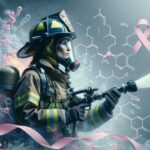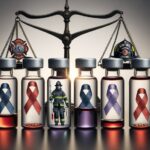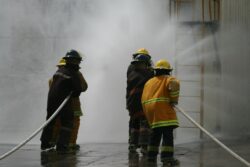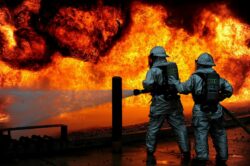Blood Cancers and AFFF: Proving the Connection
We're exploring the link between AFFF exposure and blood cancers, underlining the importance of connecting PFAS chemicals like PFOS and PFOA to diseases such as leukemia, lymphoma, and multiple myeloma. Legal challenges involve proving this association, essential for firefighters and military personnel, who are at greater risk due to their proximity to AFFF. With PFAS known for bioaccumulation and its persistent nature, efforts to establish causality intensify, supporting ongoing lawsuits and claims. It's clear that protective measures and regulations are imperative. As we navigate the legal and scientific intricacies, further insights emerge, enhancing our understanding and guiding future actions.
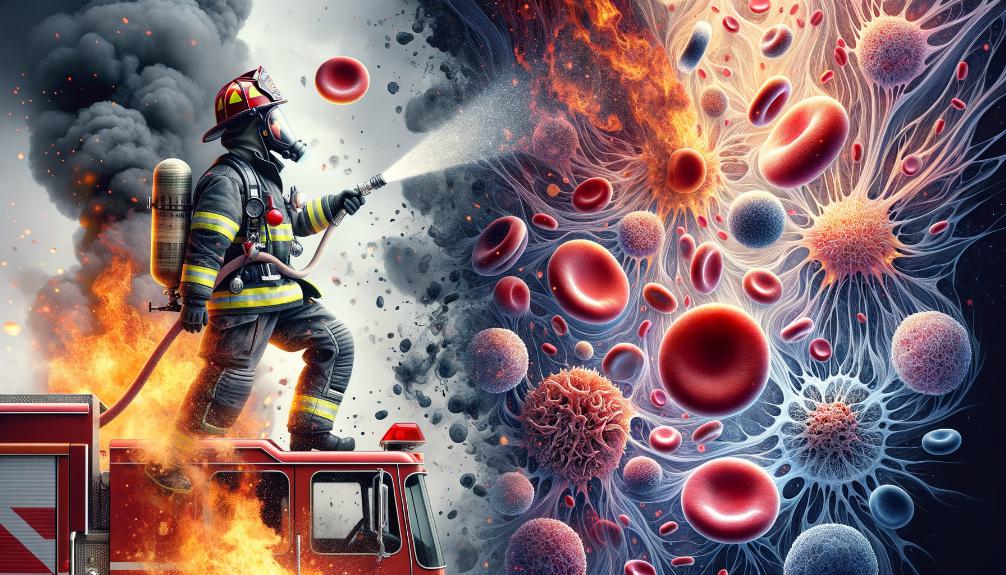
Key Takeaways
- PFAS chemicals in AFFF are linked to increased risks of leukemia and lymphoma.
- Firefighters exhibit elevated PFAS levels due to AFFF exposure, correlating with higher cancer rates.
- Studies focus on understanding AFFF's role in the development of blood cancers.
- Legal cases hinge on demonstrating AFFF exposure's connection to hematologic malignancies.
- Protective measures and PPE are essential for those at risk to minimize AFFF exposure.
Understanding AFFF

Aqueous Film Forming Foam (AFFF), widely used to combat fuel fires, contains harmful chemicals that pose significant health risks. This firefighting foam is essential for tackling flammable-liquid fires, especially on ships, by creating a barrier that deprives the fire of oxygen. However, the presence of toxic and potentially carcinogenic chemicals such as PFOS and PFOA within AFFF raises grave concerns. We've come to understand that these substances are not just harmful; they're a direct threat to our health, particularly to those of us exposed in the line of duty.
The health risks associated with AFFF exposure are alarming. Research indicates that PFAS chemicals, found in this firefighting foam, can accumulate in our bodies, leading to an increased risk of various cancers, including kidney, prostate, and testicular cancers. It's disconcerting to know that the very substance we rely on to save lives could be jeopardizing our health.
Moreover, long-term exposure to AFFF isn't just a potential cancer risk. It has been linked to a range of serious health effects, such as high cholesterol, liver damage, thyroid disease, and asthma. These findings underscore the urgent need for us to reassess our use of AFFF and explore safer alternatives. As we continue to protect our communities from the ravages of fire, we must also protect ourselves and future generations from the hidden dangers posed by exposure to carcinogenic chemicals in firefighting foams. The balance between efficacy in emergency situations and long-term health consequences is a challenge we must address head-on.
PFAS Chemicals Overview
PFAS chemicals, including the notorious PFOS and PFOA found in AFFF firefighting foam, have become a major concern due to their persistence in the environment and potential health risks. These substances are not just present in the line of duty for firefighters but can also contaminate water sources, making their way into our bodies. The fact that they can bioaccumulate over time means that their effects are not immediate but can manifest after prolonged exposure.
The link between PFAS exposure and blood cancers, such as leukemia, has been a critical point of concern. Research indicates that these chemicals, due to their ability to linger in the human body and the environment, may play a role in the onset of various cancers. It's particularly alarming for those directly handling AFFF firefighting foam, as their risk of exposure is notably higher. This includes firefighters and workers in industries where AFFF is used.
Given the seriousness of these findings, it's essential we comprehend the full extent of PFAS chemicals' impact. The long half-lives of PFOS and PFOA mean they're not just a temporary problem but a persistent threat. As studies explore deeper into the potential connection between PFAS exposure and the development of blood cancers like leukemia, it's essential for those at risk to be aware of the dangers.
Our focus on PFAS chemicals and their association with health risks, especially blood cancers, underscores the need for strict regulations and protective measures for those exposed to AFFF firefighting foam. Awareness and prevention are key in mitigating the risks associated with these hazardous chemicals.
Blood Cancer Types Linked
We've identified leukemia, lymphoma, and multiple myeloma as blood cancers linked to exposure to AFFF, showcasing a clear correlation that demands our attention. These findings underscore the importance of understanding the potential health risks associated with AFFF exposure, particularly for individuals who may be at an increased risk of developing these serious conditions. The evidence points to a disturbing connection between the toxic PFAS chemicals found in AFFF foam and the onset of these hematologic malignancies.
Research has consistently shown that individuals exposed to AFFF, and consequently to elevated levels of PFAS chemicals, face a higher likelihood of developing blood cancers such as leukemia, lymphoma, and multiple myeloma. These types of cancer, collectively known as blood cancer types linked to AFFF exposure, represent a significant aspect of the broader conversation about the safety and health implications of using AFFF.
The association between AFFF exposure and an increased risk of blood cancers highlights the critical need for ongoing investigation and action. This is particularly relevant given the unique properties of PFAS chemicals, which are not only persistent in the environment but also in the human body, potentially contributing to the development of these cancers over time.
As we continue to explore further into the impacts of AFFF exposure, it's crucial to keep in mind the well-being of those most at risk. The link between AFFF and blood cancers such as leukemia, lymphoma, and multiple myeloma cannot be overlooked, emphasizing the urgency of addressing this public health concern.
Firefighters Exposure Risks
Firefighters, often praised as heroes, face a starkly increased risk of developing blood cancers due to their exposure to AFFF, which contains dangerous PFAS chemicals. These brave individuals, dedicated to saving lives, find themselves confronting a significant health hazard stemming from the very tools they use to combat fires. AFFF, or aqueous film-forming foam, is commonly used in firefighting, especially in situations involving highly flammable liquids. However, the presence of PFAS chemicals in AFFF has been associated with an alarming rise in blood cancers among firefighters, including leukemia and lymphoma.
The connection between AFFF exposure and the likelihood of developing blood cancers is becoming increasingly apparent. Studies have highlighted the heightened risk that firefighters face, particularly those with high levels of exposure to these hazardous substances. These PFAS chemicals, recognized for their persistence in the environment and the human body, contribute to the elevated rates of blood cancers observed in the firefighting community.
We're facing a serious concern: the exposure risks associated with AFFF usage and the undeniable link to blood cancers. The evidence points to a direct association between the presence of PFAS chemicals in firefighting foams and an increased incidence of leukemia and lymphoma among firefighters. This situation emphasizes the urgent need for measures to protect these essential workers from the hidden health risks posed by AFFF. As we further explore these risks, it's essential to recognize the sacrifice firefighters make and the importance of safeguarding their health against the unseen dangers of their heroic profession.
AFFF and Cancer Research
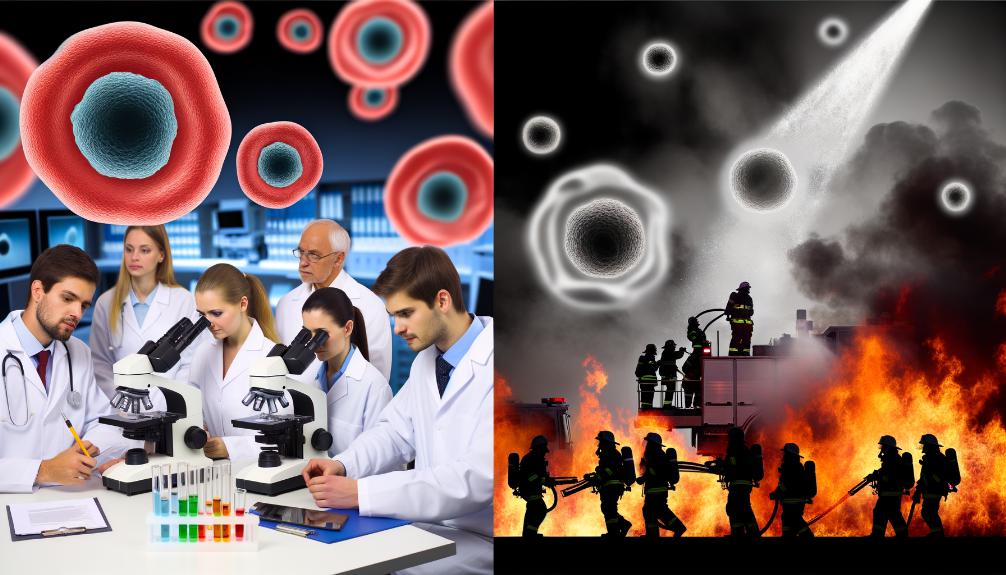
Exploring the connection between AFFF and cancer, recent studies have intensified efforts to understand how long-term exposure to this firefighting foam contributes to the development of blood cancers. It's become increasingly clear that AFFF, containing PFAS chemicals, is not as benign as once thought. The link between AFFF exposure and blood cancers such as leukemia and lymphoma is drawing significant attention from the research community.
Our exploration into the research reveals that firefighters, often in close contact with AFFF, have shown elevated levels of PFAS in their blood. This correlation raises undeniable concerns about the risks of blood cancer among these professionals. The presence of PFAS chemicals in AFFF has been particularly implicated in increasing the incidence of these devastating diseases. Individuals with significant exposure to these substances are at an alarming risk, highlighting a pressing need for more thorough research.
The potential for AFFF exposure to be a contributing factor in the development of blood cancers underscores the urgency of our investigations. It's not just about identifying the risks; it's about understanding the mechanisms at play and how long-term exposure to PFAS chemicals can lead to such significant health outcomes. The elevated levels of PFAS found in individuals exposed to AFFF demand a closer examination, not only to quantify the risk but also to pave the way for better protective measures and possibly, future litigation.
Symptoms of AFFF Exposure
We've come to realize that understanding the signs of AFFF exposure is vital for those who may have come into contact with this foam, especially firefighters who are at a higher risk. By outlining the timeline of health impacts, we aim to provide a clearer picture of the potential long-term consequences. Seeking medical advice if any symptoms arise is imperative, as early detection can greatly influence the management and outcome of related health conditions.
Identifying Exposure Signs
Often, individuals exposed to AFFF may initially experience symptoms such as skin and eye irritation, nausea, and muscle weakness, which are important to recognize early. Recognizing early signs of AFFF exposure is vital for identifying potential risks of blood cancers and taking timely preventive measures. Symptoms like nausea, vomiting, and fatigue, alongside the more immediate skin and eye irritation, serve as early warnings. Firefighters, who may have higher levels of AFFF exposure, often show signs of DNA damage, which escalates the risk of developing blood cancers such as leukemia and lymphoma. Inhalation effects of AFFF are particularly concerning, as they can lead to long-term health consequences, including the development of blood cancers over time. It's imperative to be vigilant about these early signs to mitigate potential risks effectively.
Health Impact Timeline
Understanding the timeline of health impacts following AFFF exposure is essential, as symptoms can range from immediate skin and eye irritation to long-term risks such as cancer. Initially, individuals might experience skin and eye burning, nausea, vomiting, muscle weakness, chest pain, and fatigue. Over time, the health effects of AFFF exposure can escalate, leading to serious conditions like cancer. This is particularly concerning due to the DNA damage inhalation of AFFF can cause, heightening the cancer risks. Firefighters, who often face high levels of AFFF exposure, are at an elevated risk, as confirmed by the CDC. The link between AFFF exposure and blood cancers underscores the critical need to understand these health effects and the associated cancer risks thoroughly.
Seeking Medical Advice
Given the serious health risks associated with AFFF exposure, it's important for anyone experiencing symptoms to seek immediate medical advice. Symptoms like skin and eye irritation, nausea, vomiting, muscle weakness, chest pain, and fatigue shouldn't be ignored. If we've been exposed to AFFF foam and notice these symptoms, we must consult a healthcare provider for an evaluation and testing. The severity of symptoms can vary, signaling potential health risks that require prompt medical attention. It's vital we don't delay in seeking medical advice upon suspecting AFFF exposure, as a timely medical assessment is key to addressing any health concerns effectively and mitigating further risks.
High-Risk Occupations
We're particularly concerned about workers in high-risk occupations, such as firefighters and military personnel, who are considerably more exposed to AFFF and, consequently, have a higher chance of developing various cancers. These professions, including professional, military, airport, ship, and volunteer firefighters, are at the forefront of exposure to aqueous film-forming foam (AFFF), heightening their risk for not only blood cancers but also endometrial, ovarian, kidney, testicular, prostate, and thyroid cancers. The duration of AFFF exposure in these high-risk occupations directly correlates with an increased risk of cancer development, emphasizing the critical nature of this issue.
Firefighters, due to their occupational hazards, are more susceptible to a range of health effects linked to AFFF exposure. These include high cholesterol, liver damage, reduced infant birth weight, thyroid disease, and asthma. The connection between AFFF exposure and the development of such serious health conditions, including blood cancers, underscores the urgent need for awareness, preventative measures, and support for affected individuals.
Fortunately, legal support and compensation options are available for those in high-risk occupations who have been diagnosed with cancer attributed to AFFF exposure. It's imperative that individuals understand the connection between their occupation, AFFF exposure, and the subsequent risk of developing cancer. This knowledge not only aids in seeking the necessary medical advice and treatment but also in exploring legal avenues for compensation. The provision of legal support for affected individuals furnishes a pathway to obtaining the compensation they deserve, offering a semblance of justice for the health risks endured in the line of duty.
Legal Case Essentials
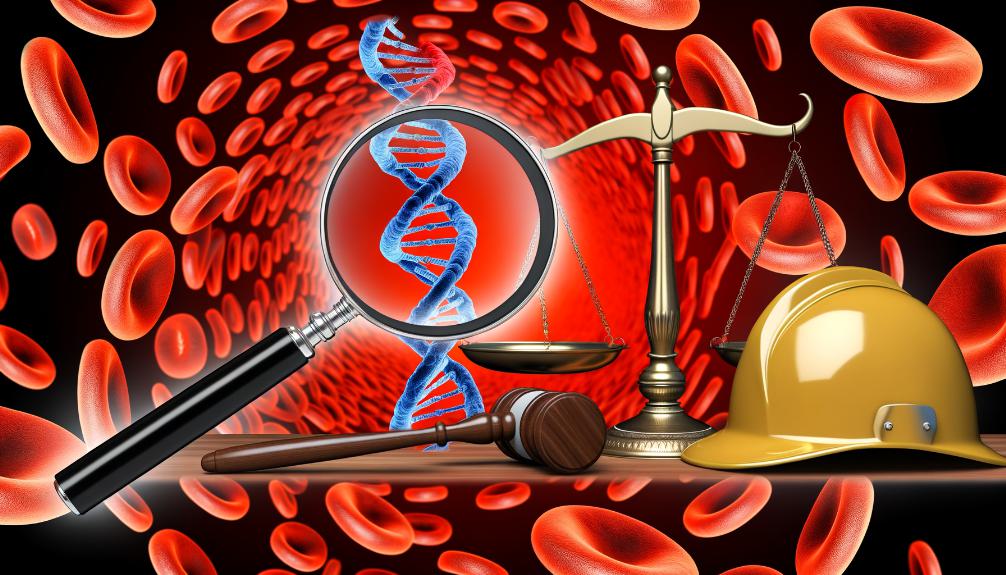
To build a persuasive legal argument for individuals impacted by blood cancers linked to AFFF exposure, it is essential to demonstrate the connection between the specific types of blood cancers and the substances present in AFFF. We must gather evidence showing the presence of PFAS chemicals in the victims' surroundings and tie these to their blood cancer diagnoses. This involves collecting detailed histories of AFFF exposure, including the time frame and duration, which are vital in proving a causal relationship in legal proceedings.
Expert testimony plays a crucial role in our legal strategy. We rely on specialists who can confirm the carcinogenic properties of PFAS chemicals found in AFFF, providing a scientific basis for the association between AFFF exposure and the development of blood cancers. Their insights, combined with scientific studies, strengthen our case by validating the link between exposure and illness.
Moreover, compiling thorough medical records is a cornerstone of our approach. These documents not only verify the diagnosis of blood cancers but also aid in establishing a timeline that supports the causal relationship between AFFF exposure and the onset of the disease. The evidence of AFFF exposure history, supported by expert testimony and medical records, forms the essence of our legal case, aiming to secure fair compensation for affected individuals.
We're committed to maneuvering through the complexities of these cases, ensuring that every piece of evidence contributes to a compelling argument for compensation. It's not just about proving a point; it's about securing justice for those who've suffered due to AFFF exposure.
Class Action Lawsuits
In recent years, class action lawsuits have emerged as a pivotal means for individuals diagnosed with blood cancers linked to AFFF exposure to seek justice and compensation from manufacturers. These legal actions are not just about holding companies accountable; they're a fight for the health and future of countless individuals who've been unknowingly exposed to significant health risks. Central to these lawsuits is the allegation that manufacturers knowingly produced AFFF containing harmful chemicals like PFAS, which are linked to blood cancers.
We're seeing an increasing number of plaintiffs come forward, presenting compelling evidence that their blood cancer diagnoses are directly connected to AFFF exposure. This evidence is essential as it forms the backbone of the class action lawsuit, aiming to prove the link between PFAS exposure and the development of blood cancers. As we stand together, our collective goal is to guarantee that those affected receive the compensation they deserve, reflecting the severity of the health risks they've been exposed to.
The focus of these lawsuits goes beyond compensation; it's also about pushing manufacturers to acknowledge the dangers associated with AFFF. By targeting the companies responsible for producing these harmful chemicals, we're not only seeking justice but also advocating for change. This change is critical to prevent future exposures and to protect the health of our communities.
In essence, these class action lawsuits represent a critical step towards recognizing and addressing the severe health risks associated with AFFF exposure. As we continue to present evidence and push for accountability, our hope is that this legal avenue will bring about the justice and compensation deserved by those impacted by blood cancers linked to AFFF.
Lawsuit Process Explained

Understanding the lawsuit process for blood cancer cases linked to AFFF exposure starts with identifying and gathering substantial evidence. We've come to realize that exploring blood cancer lawsuits requires a thorough investigation into the connection between firefighting foam chemicals and the onset of specific blood cancers such as leukemia, lymphoma, or myeloma. This journey isn't straightforward, but it's a path we're committed to delving into for those affected.
Our approach in these legal battles hinges on demonstrating a causal relationship between AFFF exposure and the diagnosis of blood cancer. It's a meticulous process, one that necessitates collecting medical documentation, expert opinions, and credible scientific research. These pieces of evidence form the backbone of our argument, showing without a doubt the link between AFFF exposure and the development of blood cancers.
Expert testimony plays a pivotal role in our strategy. These professionals help us interpret medical records and research findings, making it easier to establish the connection we're fighting to prove. Their insights are invaluable, lending credence to the claims of those who've suffered due to AFFF exposure.
We're well aware that this process can be overwhelming for our clients. That's why we're here to guide them through each step, ensuring they understand how we're building a case to support their claim. By meticulously piecing together the evidence, we aim to present a compelling argument that AFFF-induced blood cancers are a reality for some, deserving of recognition and restitution. This journey, while challenging, is one we're dedicated to, in our pursuit of justice for our clients.
Reducing AFFF Exposure
As we explore measures to mitigate AFFF exposure, it's important we emphasize the role of workplace safety protocols and the correct use of personal protective equipment (PPE). These strategies are fundamental in safeguarding our firefighters from the potential health risks posed by AFFF. Implementing these measures effectively can greatly lessen exposure and, consequently, the associated health hazards.
Workplace Safety Protocols
To effectively combat the risks associated with AFFF, we must prioritize proper training and strict adherence to workplace safety protocols. Implementing stringent decontamination procedures after exposure is essential in minimizing the risk of contamination and subsequent health issues. Regular equipment maintenance and inspection are key to ensuring that AFFF-containing gear does not pose additional exposure risks. Additionally, the introduction of advanced ventilation systems in firefighting facilities can greatly control and reduce the dispersal of AFFF particles, thereby decreasing exposure levels for firefighters. In addition, creating designated AFFF handling areas with specialized containment measures can effectively limit the spread of AFFF contaminants and lower the overall exposure risk for firefighting personnel. It's important for us to uphold these protocols to protect our firefighters from unnecessary AFFF exposure risks.
Personal Protective Equipment
After emphasizing the importance of workplace safety protocols and decontamination procedures, we'll now focus on how wearing full personal protective equipment (PPE) greatly decreases exposure to harmful AFFF chemicals. Donning full PPE and a self-contained breathing apparatus (SCBA) is crucial in mitigating exposure risk when handling AFFF, effectively preventing the inhalation of fumes and minimizing potential health hazards. Immediate actions like disposing of old AFFF stock and using cleaning wipes on exposed areas reduce skin contact, while thoroughly cleaning contaminated equipment, including PPE and SCBA, is essential. Showering within an hour after exposure can markedly lower the risk of absorbing AFFF chemicals, safeguarding against the adverse health effects linked to skin contact with these substances.
After a Cancer Diagnosis
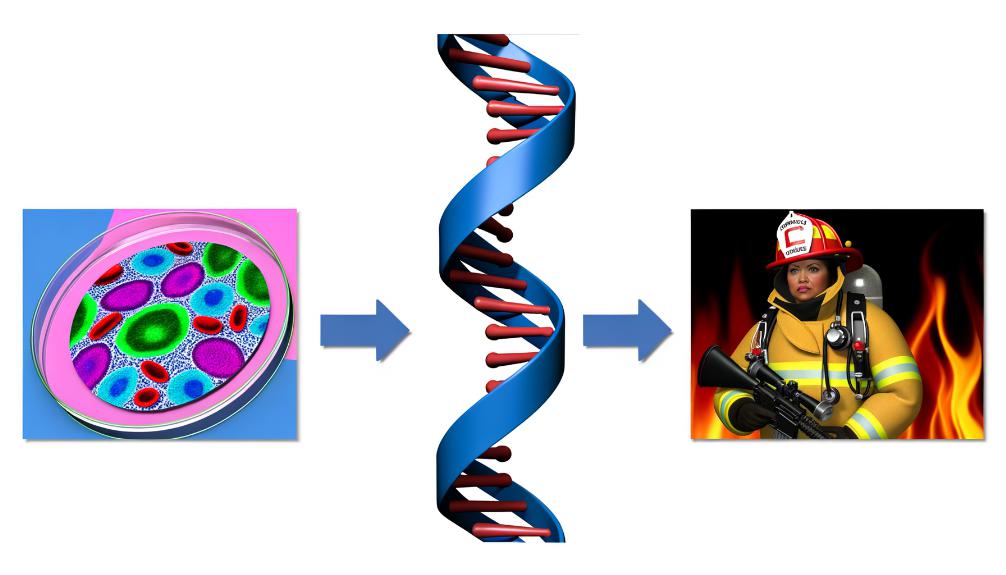
After a cancer diagnosis linked to AFFF exposure, we're faced with the challenging task of establishing a solid connection between the two. Proving causation between blood cancers and AFFF exposure is no small feat. It demands a detailed compilation of medical evidence, a detailed exposure history, and the support of expert testimony. This process is vital for those of us managing the aftermath of a cancer diagnosis, working to understand and demonstrate how AFFF exposure has impacted our health.
To construct a strong case, we must gather thorough medical records that document our diagnosis and treatment. This medical evidence serves as the foundation of our claim, illustrating the severity and specifics of our blood cancer. In parallel, detailing our exposure history to AFFF becomes essential. It involves documenting the extent, duration, and circumstances under which we were exposed to AFFF, which requires meticulous attention to detail and accuracy.
Expert testimony plays a crucial role in bridging the gap between our AFFF exposure and blood cancer diagnosis. Specialists in fields related to toxic exposure and oncology can provide authoritative opinions, reinforcing the connection and strengthening our case. Their insights are invaluable in proving causation, making their involvement a critical aspect of our journey post-cancer diagnosis.
Handling this complex process post-diagnosis is challenging, and while the specifics of seeking legal assistance will be explored next, it's evident that enlisting legal help is an important step. Experienced attorneys not only guide us through the intricate legal landscape but also make sure our case is presented compellingly, maximizing our chances of establishing the connection and seeking justice.
Seeking Legal Assistance
As we explore the necessity of seeking legal assistance, it's clear that experienced lawyers are pivotal in linking AFFF exposure to blood cancers. They guide us through the intricate process of filing a claim, ensuring we're well-represented and our case is compelling. Their expertise not only aids in gathering critical evidence but also in securing the compensation and justice deserved.
Legal Representation Benefits
Seeking legal representation can greatly simplify the intricate process of proving the connection between blood cancers and AFFF exposure. With the aid of experienced attorneys, we're better equipped to identify responsible parties, gather necessary evidence, and construct a compelling case for compensation. These legal professionals specialize in AFFF cases, deeply understanding the complexities of proving causation. Their expertise not only aids in maneuvering the legal landscape but also greatly enhances our chances of pursuing justice effectively. By consulting with knowledgeable attorneys, we're taking an essential step towards securing the compensation deserved, ensuring that those accountable for AFFF-related blood cancers are held responsible. Their guidance through evidence gathering and case building is invaluable in our journey towards justice.
Filing Your Claim
Having explored the benefits of legal representation, we'll now focus on how to file your claim with the assistance of a lawyer experienced in AFFF-related cancer cases. When filing a claim, it's important to gather all necessary documentation, including evidence of AFFF exposure and medical records confirming your blood cancer diagnosis. This evidence is essential in proving the connection between AFFF exposure and your illness. Legal assistance can guide you through the complexities of understanding your legal options and the specific criteria required for your claim. A lawyer handling AFFF-related cases will be instrumental in addressing these challenges, ensuring that your claim is filed correctly and efficiently, maximizing your chances of receiving the compensation you deserve for your suffering.

This post has been generated by AI and was not reviewed by editors. This is Not legal advice. Please consult with an attorney.
